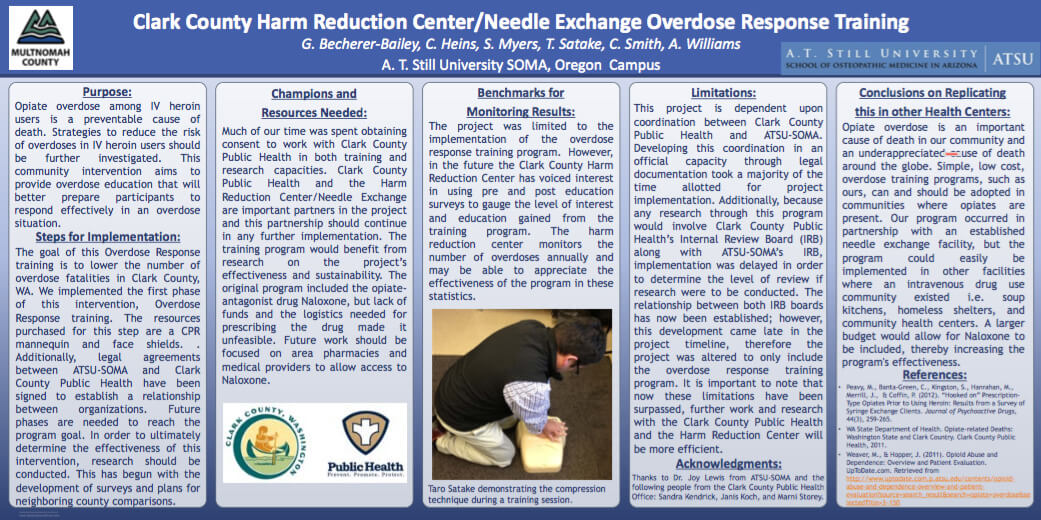Clark County Harm Reduction Center/Needle Exchange Overdose Response Training
SOMA is focused on ensuring that you are successful in your pursuit of a Doctor of Osteopathic Medicine. Faculty and staff are all committed to providing you the support needed to excel in the study of medicine. This is part of the community spirit of A.T. Still University, which has a long culture of encouraging, supporting and helping each other as colleagues
This type of support enabled 100% of SOMA Class of 2011 graduates to be selected to participate in a post-doctoral internship or residency program upon completion of their D.O. degrees.
Community Campuses are staffed by SOMA faculty, who are also practicing clinicians. Your Community Campus learning facilitators play a central role in guiding you through your second year learning. In addition, you have the full support of the SOMA faculty in Mesa and the assistance of ATSU Student Services. It’s a proven support system for your success.
Purpose
Opiate overdose among IV heroin users is a preventable cause of death. Strategies to reduce the risk of overdoses in IV heroin users should be further investigated. This community intervention aims to provide overdose education that will better prepare participants to respond effectively in an overdose situation.
Steps for Implementation
The goal of this Overdose Response training is to lower the number of overdose fatalities in Clark County, WA. We implemented the first phase of this intervention, Overdose Response training. The resources purchased for this step are a CPR mannequin and face shields. . Additionally, legal agreements between ATSU-SOMA and Clark County Public Health have been signed to establish a relationship between organizations. Future phases are needed to reach the program goal. In order to ultimately determine the effectiveness of this intervention, research should be conducted. This has begun with the development of surveys and plans for neighboring county comparisons.
Champions and Resources Needed: Much of our time was spent obtaining consent to work with Clark County Public Health in both training and research capacities. Clark County Public Health and the Harm Reduction Center/Needle Exchange are important partners in the project and this partnership should continue in any further implementation. The training program would benefit from research on the project’s effectiveness and sustainability. The original program included the opiate-antagonist drug Naloxone, but lack of funds and the logistics needed for prescribing the drug made it unfeasible. Future work should be focused on area pharmacies and medical providers to allow access to Naloxone.
Benchmarks for Monitoring Results
The project was limited to the implementation of the overdose response training program. However, in the future the Clark County Harm Reduction Center has voiced interest in using pre and post education surveys to gauge the level of interest and education gained from the training program. The harm reduction center monitors the number of overdoses annually and may be able to appreciate the effectiveness of the program in these statistics.
Limitations
This project is dependent upon coordination between Clark County Public Health and ATSU-SOMA. Developing this coordination in an official capacity through legal documentation took a majority of the time allotted for project implementation. Additionally, because any research through this program would involve Clark County Public Health’s Internal Review Board (IRB) along with ATSU- SOMA’s IRB, implementation was delayed in order to determine the level of review if research were to be conducted. The relationship between both IRB boards has now been established; however, this development came late in the project timeline, therefore the project was altered to only include the overdose response training program. It is important to note that now these limitations have been surpassed, further work and research with the Clark County Public Health and the Harm Reduction Center will be more efficient.
Conclusions on Replicating this in other Health Centers
Opiate overdose is an important cause of death in our community and an underappreciated cause of death around the globe. Simple, low cost, overdose training programs, such as ours, can and should be adopted in communities where opiates are present. Our program occurred in partnership with an established needle exchange facility, but the program could easily be implemented in other facilities where an intravenous drug use community existed i.e. soup kitchens, homeless shelters, and community health centers. A larger budget would allow for Naloxone to be included, thereby increasing the program's effectiveness.
